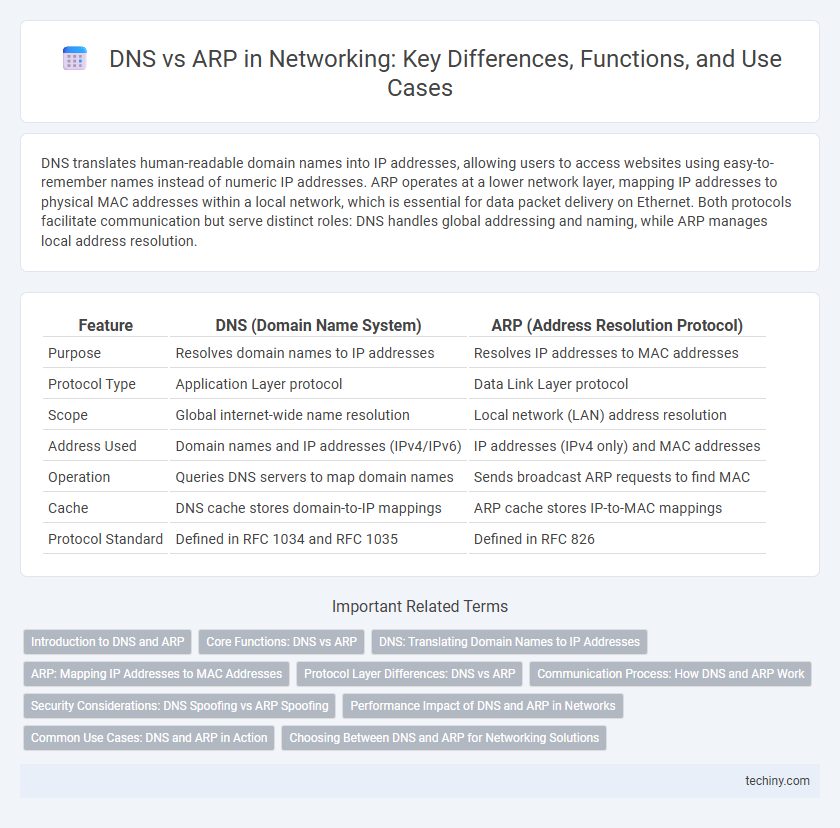DNS translates human-readable domain names into IP addresses, allowing users to access websites using easy-to-remember names instead of numeric IP addresses. ARP operates at a lower network layer, mapping IP addresses to physical MAC addresses within a local network, which is essential for data packet delivery on Ethernet. Both protocols facilitate communication but serve distinct roles: DNS handles global addressing and naming, while ARP manages local address resolution.
Table of Comparison
| Feature | DNS (Domain Name System) | ARP (Address Resolution Protocol) |
|---|---|---|
| Purpose | Resolves domain names to IP addresses | Resolves IP addresses to MAC addresses |
| Protocol Type | Application Layer protocol | Data Link Layer protocol |
| Scope | Global internet-wide name resolution | Local network (LAN) address resolution |
| Address Used | Domain names and IP addresses (IPv4/IPv6) | IP addresses (IPv4 only) and MAC addresses |
| Operation | Queries DNS servers to map domain names | Sends broadcast ARP requests to find MAC |
| Cache | DNS cache stores domain-to-IP mappings | ARP cache stores IP-to-MAC mappings |
| Protocol Standard | Defined in RFC 1034 and RFC 1035 | Defined in RFC 826 |
Introduction to DNS and ARP
DNS (Domain Name System) translates human-readable domain names into IP addresses, enabling users to access websites using memorable names instead of numeric IPs. ARP (Address Resolution Protocol) resolves IP addresses to physical MAC addresses within a local network, facilitating communication between devices on the same subnet. Both DNS and ARP play critical roles in network layer functions by mapping identifiers to addresses for data routing and delivery.
Core Functions: DNS vs ARP
DNS translates human-readable domain names into IP addresses, enabling efficient location of internet resources. ARP resolves IP addresses to MAC addresses within local networks, facilitating direct device-to-device communication. Both protocols are essential for network functionality but operate at different layers, with DNS functioning at the application layer and ARP at the data link layer.
DNS: Translating Domain Names to IP Addresses
DNS translates human-readable domain names like example.com into IP addresses such as 192.0.2.1, enabling devices to locate servers on the internet quickly. It operates through a hierarchical system of DNS servers, including root, TLD, and authoritative servers, ensuring accurate and efficient resolution. This process differs from ARP, which maps IP addresses to MAC addresses within local networks, making DNS essential for global internet communication.
ARP: Mapping IP Addresses to MAC Addresses
ARP (Address Resolution Protocol) is essential for mapping IP addresses to MAC addresses within a local network, enabling efficient communication between devices. Unlike DNS, which translates domain names to IP addresses at the application layer, ARP operates at the network layer to resolve IP addresses into hardware addresses required for data link layer delivery. This protocol sends broadcast requests in the local subnet to discover the MAC address corresponding to a specific IP, facilitating accurate packet forwarding in Ethernet networks.
Protocol Layer Differences: DNS vs ARP
DNS operates at the application layer, translating domain names into IP addresses to facilitate user-friendly network navigation. ARP functions at the data link layer, resolving IP addresses to MAC addresses for local network communication. These protocol layer differences highlight DNS's role in global addressing and ARP's critical function in local device identification.
Communication Process: How DNS and ARP Work
DNS translates human-readable domain names into IP addresses, enabling devices to locate websites and services across the internet. ARP resolves IP addresses to MAC addresses within a local network, allowing devices to communicate over Ethernet. Both protocols facilitate network communication by mapping addresses at different layers--DNS at the application layer and ARP at the data link layer.
Security Considerations: DNS Spoofing vs ARP Spoofing
DNS spoofing targets the resolution of domain names by injecting malicious DNS responses, redirecting users to fraudulent websites and enabling phishing attacks. ARP spoofing manipulates the local network's Address Resolution Protocol to intercept, modify, or block data between devices, facilitating man-in-the-middle attacks and session hijacking. Implementing DNSSEC for DNS security and dynamic ARP inspection (DAI) for ARP protection are critical measures to mitigate these spoofing threats.
Performance Impact of DNS and ARP in Networks
DNS enhances network performance by efficiently translating domain names into IP addresses, reducing latency during resource access and minimizing manual IP configuration errors. ARP operates at a lower network layer, rapidly resolving IP addresses to MAC addresses within local subnetworks, which is critical for maintaining swift data transmission without incurring significant overhead. While DNS queries may introduce slight delays due to recursive lookups, ARP requests are typically faster but can increase broadcast traffic in large networks, impacting network scalability and congestion.
Common Use Cases: DNS and ARP in Action
DNS translates human-readable domain names into IP addresses, enabling users to access websites and online services effortlessly. ARP resolves IP addresses to MAC addresses within a local network, facilitating communication between devices on the same subnet. Together, DNS and ARP streamline network connectivity by managing address resolution at different layers: DNS for global domain names and ARP for local hardware identification.
Choosing Between DNS and ARP for Networking Solutions
DNS resolves human-readable domain names into IP addresses, essential for internet-wide communication, while ARP maps IP addresses to MAC addresses within local networks to facilitate device-level data transfer. Choosing between DNS and ARP depends on the networking scope: DNS is optimal for resolving hostnames across the internet or intranets, whereas ARP is critical for address resolution within a LAN environment. Integrating DNS for application-layer name resolution alongside ARP for link-layer address mapping ensures comprehensive and efficient network communication.
DNS vs ARP Infographic

 techiny.com
techiny.com